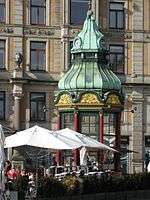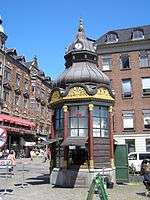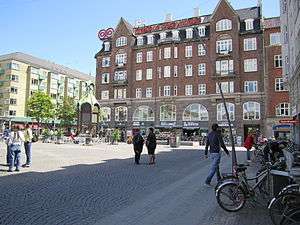A/S Københavns Telefonkiosker
A/S Københavns Telefonkiosker (old spelling: A/S Kjøbenhavns Telefonkiosker), often referred to as KTK, was an operator of staffed telephone kiosks in Copenhagen, Denmark. The first telephone kiosks were installed in 1896 to an Art Nouveau-influenced National Romantic design by Fritz Koch. A new and somewhat larger model was introduced in 1913, although Koch's original design was again used in 1929.
Eight of telephone kiosks have survived and most of them are now used as café pavilions. One of Koch's telephone kiosks, located at Poul Henningsens Plads in Østerbro, was listed in 1996. Another one has been moved to Gabels Torv in Aalborg.
History
The first 10 kiosks
.jpg)
The first telephone company in Copenhagen was established in 1877 and came and Københavns Telefonselskab (KTAS) was founded in 1882. In 1989, it still only had 1,487 out of a population of more than 250,000 in the city. The need for public telephones was therefore evident.[1] On 3 September 1895, A/S Kjøbenhavns Telefonkiosker obtained a concession from the city magistrate on the installation and operation of up to 15 telephone kiosks in a 15-year period in Copenhagen.[2][3][4]
Fritz Koch, an assistant for city architect Ludvig Fenger, was charged with the design of the new kiosks. The first four kiosks opned at Kongens Nytorv, Gammeltorv, Nørre Boulevard (now Nørre Voldgade) and the City Hall Square on 1 June 1906 . They were followed by kiosks at Gyldenløvesgade, Grønningen, Vesterbros Torv, Sølvtorvet, Dronning Louises Bro and Sankt Annæ Plads later that same year. bringing the total number of telephone kiosks up to 10. Another one, located at Lille Triangel in
Østerbro, opened in 1897 but then the construction stopped.
.jpg)
The inspiration for the kiosks came from Paris. They were open from 7 a.m. to 11 p.m. and each kiosk contained two telephones. The kiosk lady also sold a wide selection of kiosk tiems such as newspapers and magazines, stamps, theatre tickets and even insurance policies. It was also possible to call the telephone kiosk to leave a message with the kiosk lady which she would then send to the recipient by bicycle messenger.
More kiosks and a new design
Fritz Koch died in 1905. Another architect, Martin Jensen, created a design for new and somewhat larger telephone kiosks in 1913. They replaced many of Koch's lopsks and were also built in a number of new locations. The new design was criticized and in 1929m when the company once again wanted to install new telephone kiosks, the city required them to be built to the old design. In 1932, Curt Bie from the city architect's office created a Functionalist design for new kiosks. A total of 30 telephone kiosks were built.
The telephone kiosksgradually lost their raison d'être as private telephones became common. Many of the kiosks were removed in connection with road expansions or redesign of public spaces.
KTK was for many years based at the City Hall Square. It later moved to the Enghave Center at Mathæusgade in Vesterbro. It was dissolved in 1980.
Design
Koch's original telephone kiosks are nine metres tall, hexagonal and with a floor area of approximately nine square metres. They are constructed in pine wood on a granite plinth. The copper roof is topped by a triangular flèche with clock faces on all sides.[4] Just below the roof are six teak tree reliefs, one on each side, featuring the 12 astrological sign. Above the reliefs is a frieze with symbolic representations of shipping (ships), industry (tools), (then) modern technology (telephoning gentlemen) and agriculture (animals and plants).
Jensen's telephone kiosks from 1913 are designed in the Neo-Baroque style.They are also hexagonal and topped by a copper roof but somewhat larger.
Legacy
Most of the surviving telephone kiosks are now used as café pavilions. The telephone kiosk at Jagtvej/Poul Henningsens Plads is the only one of Koch's ten original kiosks that still stands in its original location. The kiosk from Sølvtorvet was moved to the "museum street" next to Museum of Copenhagen in Absalonsgade. The one from Lille Triangel was acquired by Nordjullands Kunstmuseum and was in 2010 rebuilt in Gabels Torv in Aalborg. The kiosks from Enghave Plads and Gammeltorv were acquired by Tivoli Gardens and at least one of them have been rebuilt in the historic gardens.[5]
The 1929 version of Koch telephone kiosks have survived in Kultorvet Christianshavns Torv and Sankt Hans Torv.
Jensen's telephone kiosks from 1913 are still seen in Nytorv, Kongens Nytorv and Nørre Voldgade but the two latter have been moved a little in connection with redesign of the surroundings.[6]
List of telephone kiosks
| Location | Image | Neighbourhood | Orifina | Coordinates | Notes |
|---|---|---|---|---|---|
| Kongens Nytorv |  | City centre | Koch, 1996 | Demolished | |
| Gammeltorv |  | City centre | Koch, 1896 | Removed, acquired by Tivoli Gardens | |
| City Hall Square |  | City centre | Koch, 1996 | Demolished | |
| Nørre Voldgade (Nørre Boulevard) |  | City centre | Koch, 1996 | Demolished | |
| Gyldenløvesgade |  | City centre | Koch, 1996 | Demolished | |
| Grønningen | City centre | Koch, 1996 | Demolished | ||
| Vesterbros Torv |  | Vesterbro | Koch, 1996 | Demolished | |
| Sølvtorvet |  | City centre | Koch, 1996 | Moved to the Museum Street at Absalonsgade | |
| Dronning Louises Bro/Nørrebrogade |  | Nørrebro | Koch, 1996 | Demolished | |
| Jagtvej/Poul Henningsens Plads |  | Østerbro | Koch | Still there and listed in 1994 | |
| Østerbrogade/Lille Triangel |  | Østerbro | Koch, 1997 | Moved to Nordjyllands Kunstmuseum in 1773 and Gabels Torv in Aalborg 2010 | |
| Kongens Nytorv |  | City centre | Jensen, 1913 | Moved a few metres in connection with a refurbishment of Kongens Nytorv in 2004[7] | |
| Nytorv |  | City centre | Jensen, 1913 | Still there | |
| Nørre Voldgade (Nørre Boulevard) |  | City centre | Jensen, 1913 | Moved from the central reservation at Frederiksborggade to the beginning of Fiolstræde | |
| Nørrebros Runddel | Nørrebro | Jensen, 1996 | Demolished | ||
| Blågårds Plads | Nørrebro | Koch, 1929 | Demolished | ||
| Kultorvet |  | City centre | Koch, 1929 | Still there | |
| Sankt Hans Torv | Nørrebro | Koch, 1996 | Still there | ||
| Sankt Annæ Plads | City centre | Koch, when? | Demolished | ||
| Enghave Plads | Vesterbro | Removed, acquired by Tivoli Gardens | |||
| Christianshavns Torv |  | Christianshavn | Koch | Still there | |
| Absalonsgade | | Vesterbro | Koch | Moved to the "museum street" at Museum of Copenhagen from its original location at Sølvtorvet | |
References
- ↑ "Telefonkiosken - og telefonens folkelige gennembrud" (in Danish). Post & Tele Museum Danmark. Retrieved 3 November 2016.
- ↑ "Frederiksbergs telefonkioskerlanguage=Danish". Historisk-Topografisk Selskab for Frederiksbergaccessdate=3 November 2016.
- ↑ "A/S Københavns Telefonkiosker" (in Danish). SelKøbenhavns Stadsarkiv. Retrieved 3 October 2016.
- 1 2 "Festtelegrammer (1926)" (in Danish). Dansk Plakatkunst. Retrieved 3 November 2016.
- ↑ "Telefonkiosker" (in Danish). Selskabet for Københavns Historie. Retrieved 3 November 2016.
- ↑ "Telefonkiosk fra Lille Triangel til Gabels Torv i Aalborg" (in Danish). Dansk teknologihistorisk Selskab. Retrieved 3 November 2016.
- ↑ "Danmarks ældste telefonboks flytter" (in Danish). PoBerlingske. Retrieved 3 November 2016.
External links
- A/S Kjøbenhavns Telefonkiosker at Copenhagen City Archives
- Greetings telefram from Kjøbenhavns Telefonkiosker
- Tekephone kiosk in Klampenborg
- Telephone kiosk in Helisngør
- Source